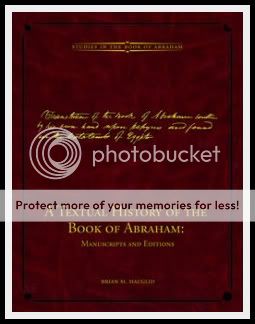 Brian M. Hauglid’s A Textual History of the Book of Abraham: Manuscripts and Editions is the latest volume in the Studies in the Book of Abraham Series from the Neal A. Maxwell Institute for Religious Scholarship. A full review is available here, and my podcast interview with Hauglid is available here. In this post I briefly compare Hauglid’s project to Royal Skousen’s project on the Book of Mormon manuscripts.
Brian M. Hauglid’s A Textual History of the Book of Abraham: Manuscripts and Editions is the latest volume in the Studies in the Book of Abraham Series from the Neal A. Maxwell Institute for Religious Scholarship. A full review is available here, and my podcast interview with Hauglid is available here. In this post I briefly compare Hauglid’s project to Royal Skousen’s project on the Book of Mormon manuscripts.
A few differences between his project and Hauglid’s are immediately apparent.
First, Skousen worked with a partially extant original manuscript and a nearly complete printer’s manuscript, in addition to the subsequent English editions. As with the Book of Mormon, a single hand-written manuscript of the entire Book of Abraham is not known. Manuscript evidence exists only for Abraham 1:1-2:18; Abraham 3:18b-26a; and explanations for Facsimiles 1 and 2 (21, this and all page references below refer to Hauglid’s A Textual History). Hauglid relies on the first published edition of the BoA in the 1842 Times and Seasons to fill the gap. According to Hauglid, Joseph Smith oversaw the T&S publication but, as far as can be seen, Smith “had no [direct] influence on the text after this publication and up until his death in June 1844” (22). Overall, Skousen had much more to work with given the respective lengths of the texts. Thus, his multi-page books do not include scanned images of the manuscripts alongside the transcription as Hauglid’s book does (in a similar fashion to the Joseph Smith Papers Revelations and Translations, Manuscript Revelation Books volume).
Second, Skousen argues that the original manuscript of the BoM shows definite signs of being a dictated text. Hauglid argues that such signs are absent in the extant BoA manuscripts. Thus, he argues they are not the results of dictation because they bear the marks of being copies from a now-unknown “earlier exemplar” he calls “Ab0” (7, 21). Through textual analysis, comparison of spelling, handwriting, punctuation, evolution of the text, etc., Hauglid lays out his evidence. The full transcriptions of each manuscript which appear in the book can be used to check out his theory, and the introduction describes the best specific evidence.
As with Skousen’s project, folks will probably be interested in the textual variants in various editions, which Hauglid identifies. Given the length of the texts it isn’t surprising that the BoA has far, far fewer substantive variations compared with the BoM. Some of the biggest changes were actually made by James E. Talmage, who used his 1888 edition of the BoA to update the text for the 1902 edition of the Pearl of Great Price. Hauglid’s 5th Appendix consists of full color images of Talmage’s 1888 edition, showing his annotations. Talmage divided up the text into the now-familiar verse structure, inserted paragraphs, changed some spelling and grammar, and made other minor adjustments.
Some of his contemplated changes were not used. For instance, Abraham 3:26 reads: “and they who keep not their first estate, shall not have glory in the same kingdom with those who keep their first estate….” Talmage crossed out “keep” and wrote “kept” in the margin in blue pencil. “Kept” was subsequently crossed out of the margin with black pencil and today the text still reads “keep” (299).
A puzzling change was made to Abraham 1:19. In the current edition, based on Talmage’s change, God tells Abraham:
As it was with Noah so shall it be with thee; but through thy ministry my name shall be known in the earth forever, for I am thy God.
As seen in the manuscript, this originally read:
As it was with Noah, so shall it be with thee, that through thy ministry my name shall be known in the earth forever, for I am thy God (289).
Evidently, Talmage wanted to differentiate Abraham from Noah in that he felt God’s name was not known in the earth forever through Noah, although I know of no specific explanation for the change.
Hauglid hopes that his new “volume will increase appreciation for the rich textual history of the Book of Abraham” (ix). I’ve already had a bit of fun with it. It’s a meticulously compiled source book for future researchers, and an interesting volume which Latter-day Saints can use to read the Book of Abraham in a different light. It’s pricey, but very well produced and highly recommended.











